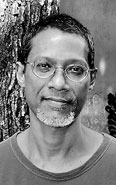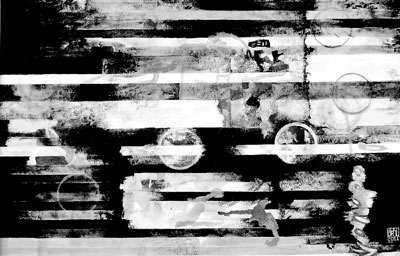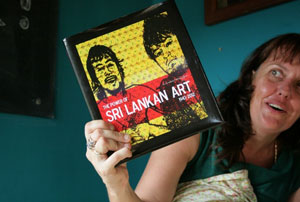A unique artist discovered
By Dr. Michael FernandoView(s):In Sri Lanka, as in many other countries, it is very difficult to discover good artists with potential when they are young. The main reason for this is that the contemporary world of art has become a jungle of planned publicity sprees within a commercialized environment. Even in societies where commercialization is not so strong, the influence of politicians bars the emergence of independent artists. In countries like Sri Lanka the ignorance of many art critics and the public in general makes it difficult for a genuine and talented artist to gain recognition in society. Most often a handful of ‘run of the mill’ artists control the scene with the help of a bunch of equally abled ‘critics.’

Leo Pasqualge
This writer is of the opinion that the few talented and intelligent artists of international standard rarely find recognition in their own home (Sri Lanka) at least during their lifetime. Some fields of art, especially literature and theatre, that use the main language of the country suffer due to the limited readership and audience and to the difficulty this entails, with regard to access to the international world of art. However, there are some genres of art such as painting and music that have the ability to overcome this hurdle due to the universality of the means of expression they employ.
This writer was surprised when he observed the plight of a Sri Lankan painter who is uniquely talented and equipped with the theoretical aspects of the genre of art he is engaged with. In a way it is a tragedy, for him as well as for Sri Lankan society.
The artist is the painter Leo Pasqualge. This writer had the opportunity to see some of his paintings about three months ago when he was preparing for the Colombo Art Biennale 2012, which was held from February 15-19. The writer also had the opportunity to see more of his works during the Biennale and to listen to a lecture he delivered on “Critique versus Criticism” at the J.D.A. Perera Art Gallery in Colombo 07. Although he did not expect a wave of appreciation of his work from the art critics of this country, neither has anyone written more than a paragraph about him.
This is an attempt to bring to the notice of the Sri Lankan public, evaluation of his works of art, appreciation of his talents and also to request the art critics of this country to observe this artist in some depth! Further, the writer wishes to inform the higher educational institutions to give an opportunity to their students to make use of his substantial knowledge of art history, aesthetic theory and talents as a painter as well. The writer is well aware, as a former head of a Department of Fine Arts of a Sri Lankan university, the dearth of qualified persons who can teach art history both ancient and modern equally well.
After discovering him as an artist with the potential to become one of the ‘great’ artists of our time, the writer made an attempt to study his background including his earlier works and the academic training he has undergone. The writer does not want to go into those details at this point to avoid harmful prejudgments in assessing him as an artist. However, anyone who would like to study him in a serious manner has to uncover the social, cultural and academic environment that shaped his artistic activity.
This writer observes several qualities of his artistic creations that make him an unusual artist. Multiplicity of themes and technical styles is one of the salient features of his art. Some themes seem to be expressive of his personal life experiences while some signify the socio-political realities of the time. Technically he uses methods that are possible only in the computer and digital age, and in a large group of his work the geometrical approach is used meaningfully.
For him, not only colour and shade but also shape seem to be of great use, and simplicity seems to be the key.
The ‘Censorship’ collection that he exhibited at the Colombo Art Biennale 2012 included the thought-provoking juxtaposition of The Participant and The Observers. Whereas The Participant consisted of a single shape, The Observers contains a multiple of the same shape on canvases of varying depth assembled to form a whole. Alongside these two works one comes across Self-censorship – a neutral grey painting with vertical white lines where the title is emblazoned across the picture plane in Braille. In White: Lines, Vans & Lies and Black: Lines, Lists & Magic he confronts the social and political realities of our time in an artistic manner. The defiant You Cannot Sit on Me Anymore is a chair that has been dismantled and then reconstructed in two dimensions.

Read between the Lines (2010)
- Read between the Lines (2010)
According to the moderate knowledge of this writer, Pasqualge has not attempted to follow the examples of individual, famous artists or art trends. He seems to be in the process of developing a multifaceted style that cannot be named using concepts such as ‘cubism’ or ‘minimalism’. Certainly, he has assimilated the essence of the geometric abstractions of the Bauhaus, the De Stijl and Constructivist movements and the simple geometric shapes and interlocking planes of Cubism. His work shares the ‘minimalist’ tendency to eliminate all nonessential forms, features or concepts and is reductive and quiet in the same manner as Japanese traditional design.
This writer did not have an opportunity to see Pasqualge’s early paintings as they were done when he was abroad. However, his recent paintings definitely show he is a socially, culturally and politically aware artist who can grasp the problems in these fields deeply and express them effectively using the multiple and unique signs available to a painter. However, he has done this in an artistic manner. Therefore, art is the winner without losing its relevance to modern society. His work neither plays to the public nor loses its identity or independence.
The writer was the Head of the Department of Fine Arts, University of Peradeniya



















